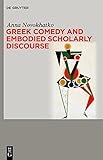Greek Comedy and Embodied Scholarly Discourse / Anna Novokhatko.
Material type: TextPublisher: Berlin ; Boston : De Gruyter, [2023]Copyright date: ©2023Description: 1 online resource (VIII, 278 p.)Content type:
TextPublisher: Berlin ; Boston : De Gruyter, [2023]Copyright date: ©2023Description: 1 online resource (VIII, 278 p.)Content type: - 9783111080932
- 9783111081762
- 9783111081540
- 882.01 23/eng/20230323
- online - DeGruyter
- Issued also in print.
| Item type | Current library | Call number | URL | Status | Notes | Barcode | |
|---|---|---|---|---|---|---|---|
 eBook
eBook
|
Biblioteca "Angelicum" Pont. Univ. S.Tommaso d'Aquino Nuvola online | online - DeGruyter (Browse shelf(Opens below)) | Online access | Not for loan (Accesso limitato) | Accesso per gli utenti autorizzati / Access for authorized users | (dgr)9783111081540 |
Frontmatter -- Preface -- Contents -- Introduction -- Chapter 1 Proto-semantic studies -- Chapter 2 Grammar with perceptual details -- Chapter 3 Approaches to style -- Chapter 4 Experiencing genres -- Chapter 5 Striding in metre -- Chapter 6 Discourse on language and dialect -- Chapter 7 Tracking Homeric criticism -- Chapter 8 The importance of being serious -- Conclusion -- Abbreviations -- Bibliography -- General Index -- Index vocabulorum Graecorum -- Index locorum
restricted access online access with authorization star
http://purl.org/coar/access_right/c_16ec
Comedy created a joyful mode of perceiving rhetoric, grammar, and literary criticism through the somatic senses of the author, the characters, the actors and the spectators. This was due to generic peculiarities including the omnivore mirroring of contemporary (scholarly) ideas, the materiality of costumes and masks, and the embodiment of abstract notions on stage, in short due to the correspondence between body, language and environment. The materiality of words, letters and syllables in ancient grammar and stylistic criticism is related to the embodied criticism found in Greek comedy. How are scholarly discourses embodied? The act of writing is vividly enacted on stage through carving with effort the shape of the letter 'rho' and commenting emotionally on it. The letters of the alphabet are danced by the chorus, the cognitive and communicative power of gestures and body expression providing emotional context. A barking pickle brine from Thasos is perhaps an olfactory somatosensory visual and auditory embodiment of Archilochean poetry, whilst the actor’s foot in dance is a visual and motor embodiment of a metrical foot on stage. Comedy with its actors, costumes, masks, and props is overflowing with such examples. In this book, the author suggests that comedy made a significant contribution to the establishment of scholarly discourses in Classical Greece.
Issued also in print.
Mode of access: Internet via World Wide Web.
In English.
Description based on online resource; title from PDF title page (publisher's Web site, viewed 06. Mrz 2024)


